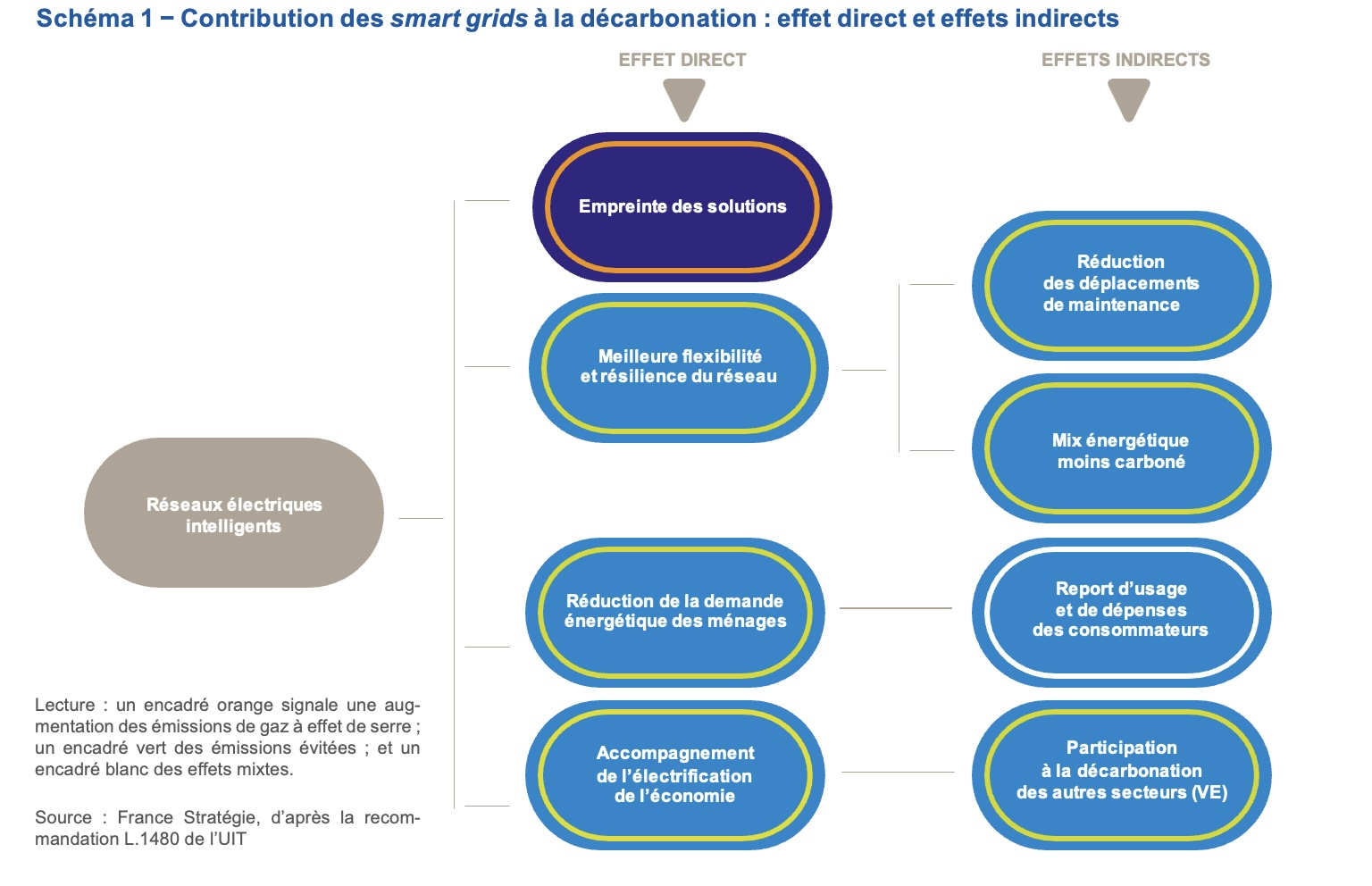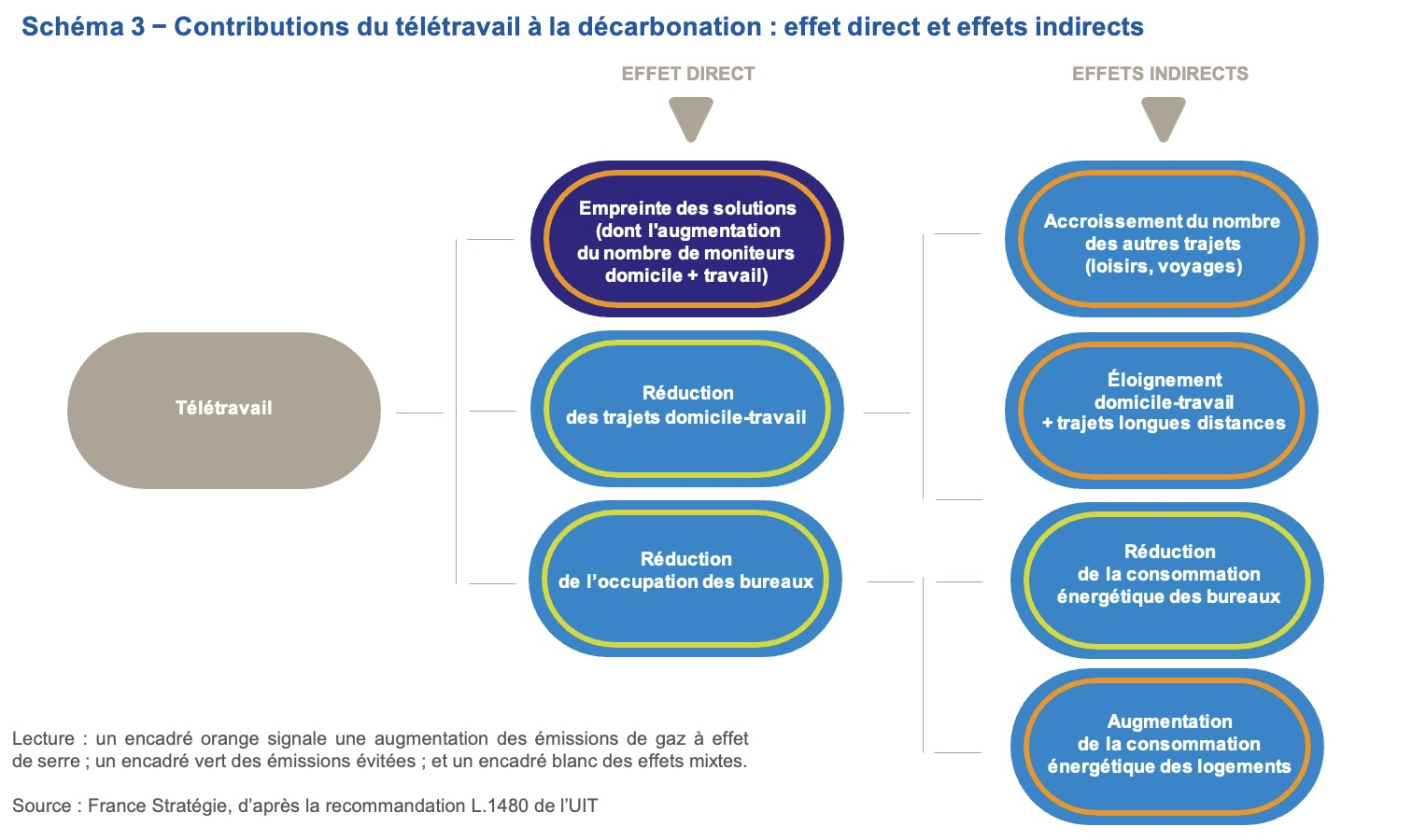Foreword
The level of carbon emissions attributed to the use of digital technologies is fairly well known. These emissions represent around 2.5% of France's carbon footprint. By 2030, in a trend scenario, they should reach 25 MtCO2e, up 45% on 2020, and electricity consumption due to the use of this equipment should rise to 54 TWh, up 5%.
But what do we know, conversely, about the contribution of digital technology to decarbonization trajectories, France Stratégie asked. "The question is complex and has not yet received a comprehensive answer.
France Stratégie set out to explore the results of economic literature to quantify the decarbonization potential of four selected use cases in the key fields of energy and transport: smart grids, smart homes, telecommuting and car-sharing.
Emissions reduction potentials take into account potential rebound effects as well as the footprint of the digital solution itself. For intelligent home management, telecommuting and car-sharing, several scenarios are studied, based on different assumptions that vary the efficiency gains as well as the magnitude of rebound effects. The results have been estimated on the basis of the current French energy mix.
Référence :
Smart grids: modest and uncertain gains for the French grid
Whether it's for electricity transmission or distribution, so-called "smart" solutions can be deployed at all levels of an electrical network. These solutions collect and analyze data, promote the circulation of information between suppliers and consumers, and enable real-time adjustment of the flow of electricity: between 2% and 10% of European household energy consumption could be saved in this way.
Smartification " ensures the balancing and flexibility of networks: thanks to smart grids, energy storage devices and "load shedding capacities" - in other words, the quantities of energy that can be punctually withdrawn from the national electricity grid to relieve it of peak consumption - can be controlled as closely as possible. We can also manage and support a growing share of electricity from renewable sources or decentralized systems, whether self-generation or "prosumers" (a consumer who has certain characteristics that bring him or her closer to the figure of a producer).
By facilitating network monitoring, smart grids improve maintenance and incident management: outage times in the event of a breakdown are reduced, and malfunctions likely to increase consumption are quickly detected. These intelligent systems also help to reduce network operating costs and reduce the need for technical teams to travel: for example, the number of interventions by Enedis teams has fallen by more than 70% since the installation of Linky meters. The gains achieved could even help to reduce the number of back-up infrastructures needed, and redirect certain investments towards greater decarbonization of the network. Part of the gains expected from smart grids are linked to smart meters (Linky in France).
In 2017, power grid operator RTE provided an initial estimate of the impact of smart grids on the French power grid. Four solutions were scrutinized: storage, active management of residential demand via smart meters and "boxes", active management of industrial and tertiary demand, and control of wind generation.
In the context of 2017, RTE estimated that the deployment of all smart grid solutions would enable a net gain in emissions of around 0.8 MtCO2/year by 2030, including the life cycle of the equipment deployed, i.e. around 3% of the French power system's annual emissions. More than two-thirds of these benefits would come from storage (batteries and STEP), " the inclusion of which in the scope of digital solutions may be debatable, however, due to the various technical devices mobilized".
"However, concludes RTE, " the use of digital technology could be more promising for certain new uses of electricity that could contribute to flexibility ". In particular, RTE mentioned the intelligent control of battery recharging for electric vehicles.

Intelligent home management: gains that depend on the deployment context
CO2 emissions linked to heating primary residences in mainland France amounted to 45 million tonnes in 2021, i.e. 1.5 tCO2 per dwelling, including indirect emissions from electric and district heating.
Today, digital solutions are available to manage systems and reduce energy consumption in the home. These intelligent home management systems (Home Energy Management Systems or HEMS) reduce energy consumption for all equipment in the home. But it's when it comes to managing room temperature (heating in particular) that these solutions offer the most interesting benefits.
France Stratégie has selected several scenarios that take into account the solution's energy efficiency gains, the rebound effects that could reduce the solution's gains by 25%, 50% or 75%, and the emissions associated with implementing the solution.
In the optimistic scenario, intelligent home management would reduce energy consumption by 20 TWh and save 3.1 MtCO2e per year for all homes in mainland France. On the other hand, it would increase energy consumption by 2 TWh and emissions by 0.1 MtCO2e in the pessimistic scenario. " Indeed, under unfavorable assumptions, energy efficiency gains after rebound effects could be insufficient to offset the emissions linked to the implementation of the solution itself".

Telecommuting: a moderate contribution with significant rebound effects
Telecommuting is often seen as a way of reducing greenhouse gas emissions on a national or city scale.
In France, according to ADEME, the emissions gains directly linked to the reduction in commuting for one day of telecommuting per week average 271 kgCO2e per year and per telecommuter. However, we need to take into account rebound effects, in particular the possible transfer to other types of commute, whether local or long-distance. " We also need to take into account the use of videoconferencing and the increase in energy consumption at home (linked to IT equipment and heating), as well as, conversely, the drop in consumption at the company".
Taking all these effects into account, ADEME estimates that the annual gains associated with one day's telecommuting would be reduced to 181 kgCO2e in the absence of flex office. On the other hand, the gains could be greater than the direct effect of reducing commuting if flex office is used: this organization of space without dedicated offices reduces the surface area used and therefore energy consumption, heating and building maintenance operations. Generally speaking, estimating rebound effects remains uncertain and tricky.
To arrive at an order of magnitude for the effects of teleworking in France, France Stratégie considered the emissions gains of all employees working in a "teleworkable" job, i.e. the optimistic assumption of 34% of the 30 million employees in France teleworking on average one day a week.
The three scenarios proposed by France Stratégie differ in the extent to which office space is optimized, and in the magnitude of the rebound effects observed. All three scenarios show a potential reduction in annual emissions, ranging from 1.8 to 4.1 MtCO2eq, or between 181 kgCO2eq and 413 kgCO2eq per teleworker.
"Over and above the high uncertainties surrounding it, such a figure highlights the fact that telecommuting alone will only make a moderate contribution to the necessary reduction in transport emissions, especially as the practice of telecommuting is tending to stabilize among employees after the sharp rise post-2019," concludes France Stratégie.

Car-sharing platforms: relatively small gains and risks of rebound
Carpooling (or ridesharing) enables several motorists to use a single private vehicle to make the same journey. The measurement of carbon gains from this practice depends on whether short-distance journeys (under 80 km) or long-distance journeys (over 80 km) are considered.
In fact, the potential gains are greater on short journeys, which are a priori more numerous, since 74% of home-work journeys are made with private vehicles. However, it is estimated that only 3% of daily carpooling is done by private individuals. Self-driving is also common on business trips, 88% of which are made with the driver alone, over short distances.
What's more, informal carpooling still far outweighs that organized by digital platforms (4% of 900,000 daily carpool trips).
Based on average distances travelled of between 10 and 24 km, and rebound effects ranging from 25% to 77%, France Stratégie evaluates potential reductions of between 0.28 and 2.17 MtCO2eq: "These gains remain fairly small compared to the necessary reduction in transport emissions: as a reminder, in 2018, the road sector alone produced 120 MtCO₂éq of emissions".
"It's very difficult to estimate the extent to which the digital platforms that are supposed to play a key role in these new forms of mobility will contribute to them, even though they are still marginal in carpooling practices today".

In conclusion
"Although not negligible, the potential of these digital solutions seems modest overall, given the current level of emissions in their sector of application," concludes France Stratégie.
"Often limited by rebound effects, the expected energy savings and emissions reductions remain largely hypothetical, generally requiring changes in user behavior. For example, if 10 million working people teleworked one day a week, this could save between 1 and 4 MtCO2 per year, depending on their behavior and the way their workspaces are organized. In an optimistic scenario, smart homes could reduce energy consumption by 20 TWh and emissions by 4 MtCO2, but under less favorable assumptions, they could lead to a net increase in these two quantities (+2 TWh and +0.1 MtCO2), given the footprint of the solution itself".
"The useful and necessary promotion of solutions that can contribute to the ecological transition must not overshadow the major challenge of controlling the environmental impact of digital uses as a whole. Digital technology will only be able to contribute to decarbonization if its use is consistent with other decarbonization actions and changes in lifestyles, thus avoiding rebound effects". ".








